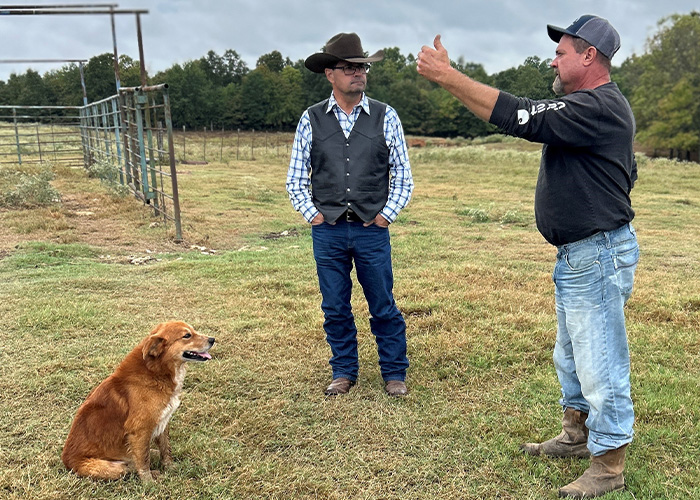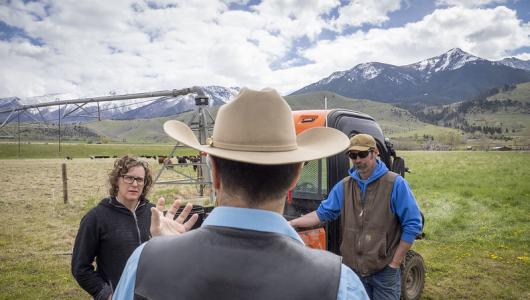I just wish I would have done this 20 years ago….30 years ago.”
Those words come from Soper, Oklahoma, rancher Porter Holder, with whom I’ve had the pleasure to get to know and work with in the past couple decades. Porter is a proud member of The Choctaw Nation of Oklahoma, a customer of the Choctaw County USDA Service Center, and a passionate advocate of regenerative grazing. I had the chance to visit his Oklahoma ranch recently, when I traveled to the state for a conservation event. He took the time to show me around and explain the benefits of his relatively recent adoption of rotational grazing practices.

Porter has used various programs available through the Farm Service Agency (FSA) and the Natural Resources Conservation Service (NRCS) in the recent past to help him maintain and build his cattle ranch into a successful business. He will tell you that these experiences of working with FSA and NRCS have been excellent, and he encourages others to consider using USDA programs to better their operations.
Using the Past to Change the Present
What’s interesting about Porter’s recommendation that others work with USDA is his history with the agency. He’s proud to have been one of the lead plaintiffs in a lawsuit against USDA, commonly known as the Keepseagle lawsuit. The plaintiffs claimed USDA discriminated against Native Americans by denying them equal access to credit in the USDA Farm Loan Program. Settled in 2011, claimants could receive financial payment and/or loan forgiveness, depending on their circumstances.
Porter’s role in the case came about when he wanted to buy his father’s ranch, but was told he didn’t have all the right information available.
“I got everything in place, but I was told I was short one tax return and that I might as well withdraw my application,” Porter said. “I didn’t want to withdraw my application.”
He moved forward anyway and was denied the loan.
“I wasn’t able to buy my home place. But later I went to (another lending institution), and they funded me on another farm,” Porter said. “So, that showed me what I had in place for a cash flow plan worked.”
Where might Porter be today if he’d had an initial positive interaction with FSA back then? How might his life’s trajectory have changed? Could he have been a leader in the regenerative soil health movement, focusing his time and attention on production improvements and his community, instead of devoting so much time, energy, and attention to the class action lawsuit he led against USDA? Had the flexibility and discretion that actually existed in the farm loan program at that time been exercised to his benefit, there’s no telling what could have been. Clearly, he had the wherewithal to make an FSA loan work. He’s still in business. Clearly, he had the management experience, and work ethic, to be a worthy investment of taxpayer resources.
If We Can, We Should
Porter’s story, and stories like his, have inspired FSA to take a different approach to create greater flexibility in its lending programs. FSA has especially worked on this point over the past three years, culminating with the September 2024 release and implementation of the “Enhancing Program Access and Delivery for Farm Loans Rule.” There are three key policy changes initiated with the rule:
- More flexible loan repayment terms, such as smaller interest-only payments on the front end of the loan or a longer repayment window, with the goal to allow producers to save for retirement, accumulate working capital, or pay college tuition;
- Lower collateral requirements for direct loans, and removing requirements that producers pledge their primary residence as collateral, to help producers forge stronger relationships with other lenders; and,
- Establish the Distressed Borrower Set-Aside Program that allows producers in financial distress to move one loan payment to the back of the term, so they can focus on next year’s production.
The rule included other changes, such as broadening loan eligibility and streamlining prior farm experience requirements, in order to provide loan access to a broader array of potential customers.
These specific changes, were they in place all those years ago, may have allowed Porter to access the farm loan he needed at the time to purchase his father’s land.

Moving Ahead with USDA
Even though he was not a beneficiary of the newly announced approach to FSA loans, Porter still shares a positive message these days when talking about his recent experiences with his local USDA agencies, because in the end, he wants what is best for the larger agricultural community and future generations.
“It truly is water under the bridge,” he said of his loan denial and subsequent lawsuit activity. “When I go in there (USDA Service Center) now, they treat me like everyone else.”
Porter has used a number of FSA programs over the past several years during particularly challenging times of drought, including Noninsured Crop Disaster Assistance Program (NAP) for disaster coverage on his grazing land, the Livestock Forage Disaster Assistance Program (LFP) and Emergency Livestock, Honey Bees and Farm-raised Fish Program (ELAP).
He also talks with excitement about his use of the NRCS’ Environmental Quality Incentives Program (EQIP). For years, Porter said, he had heard about how rotational grazing could be a tool for improving the 320 acres of pasture that support his Brangus cattle herd. After doing some research, reading, talking to other ranchers and watching online videos that discussed regenerative grazing, he decided to put in his first cross fence, using EQIP cost-share for the fencing. He did the labor himself.
He was stunned by the results.
“In just the first two years, once I had the basic infrastructure in place, I had enough grass that I was able to sell the bottom of my cows (older cows) and keep more of my heifers,” Porter said.
Through the years, he has added more cross fencing and distributed water resources so that he now has seven paddocks. In the summer his cattle graze three days on a paddock and then they move to the next location. In the spring, his cattle will move as often as every day.
“Your soil will heal itself if you help it with rest,” Porter said. “I believe there is a formula for every part of the nation to reach optimal soil health. At the end of the day, that’s what it’s about. I like to call myself a rancher because that’s seen as something ‘cool.’ But now, I’m really a grass farmer."
“I just wish I would have done this 20 years ago….30 years ago.”
Engaged for the Future
Circling back, Porter notes the challenges he experienced with USDA in those early years has led to agency improvements that he called “amazing.”
The enhancements to the FSA farm loan programs are designed to help ensure a different story is written for producers, one that leverages opportunity, by providing timely, affordable capital at terms that producers have a voice in. We must continue this important work, with a goal to promote resilience, productivity, and success. It’s critical work that will hopefully ensure the next generation’s agricultural story isn’t delayed by decades.
Zach Ducheneaux is Administrator of USDA’s Farm Service Agency. He was appointed to his current role in February 2021. He previously served as the Executive Director of the Intertribal Agriculture Council and had been with the IAC since the 1990s. He is a member of the Cheyenne River Sioux Tribe. His family still operates the 4th generation ranch on the Cheyenne River Sioux Reservation in South Dakota.


